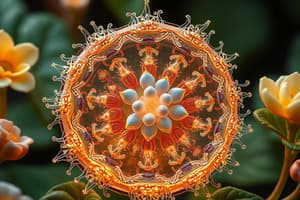Podcast
Questions and Answers
What are the three distinct membranes found in the chloroplast?
What are the three distinct membranes found in the chloroplast?
The outer membrane, the inner membrane, and the thylakoid membrane
What is the function of the thylakoid membrane in the chloroplast?
What is the function of the thylakoid membrane in the chloroplast?
It contains all the energy-generating systems of the chloroplast, including the green pigment chlorophyll
What is the name of the flattened disc-like sacs formed by the thylakoid membrane?
What is the name of the flattened disc-like sacs formed by the thylakoid membrane?
Thylakoids
What are the three separate internal compartments of the chloroplast?
What are the three separate internal compartments of the chloroplast?
What is the role of the stroma in the chloroplast?
What is the role of the stroma in the chloroplast?
What is the mechanism by which chloroplasts and mitochondria generate ATP?
What is the mechanism by which chloroplasts and mitochondria generate ATP?
What is the energy source and reducing power used to reduce CO2 in the light-independent reactions of photosynthesis?
What is the energy source and reducing power used to reduce CO2 in the light-independent reactions of photosynthesis?
What is the purpose of the proton pump in the first stage of chemiosmosis?
What is the purpose of the proton pump in the first stage of chemiosmosis?
What is the source of the protons used to create the proton gradient in chemiosmosis?
What is the source of the protons used to create the proton gradient in chemiosmosis?
What is the role of ATP synthase in chemiosmosis?
What is the role of ATP synthase in chemiosmosis?
What is the relationship between the proton gradient and ATP synthesis?
What is the relationship between the proton gradient and ATP synthesis?
In which organelles does chemiosmosis occur?
In which organelles does chemiosmosis occur?
Flashcards are hidden until you start studying
Study Notes
Chloroplast Structure
- Chloroplasts have three distinct membranes: outer, inner, and thylakoid membranes.
- The thylakoid membrane forms flattened disc-like sacs called thylakoids, which contain energy-generating systems, including chlorophyll.
- Individual thylakoids are interconnected via lamellae and tend to stack to form grana.
Chloroplast Compartments
- Chloroplasts have three internal compartments: intermembrane space, stroma, and thylakoid space.
- The stroma contains photosynthetic metabolic enzymes, ribosomes, DNA, and RNA.
Photosynthesis
- Both stages of photosynthesis depend on the chloroplast.
- Stage 1: Photolysis of H2O produces O2, ATP, and NADPH.
- Stage 2: ATP and NADPH are used to reduce CO2, producing sugar.
Light-Capturing Systems
- Light-absorbing chlorophyll, photosystem protein complexes, electron-transport chains, and ATP synthase are located on the thylakoid membrane.
- Water is split by photosystem II on the side of the membrane facing the thylakoid space.
ATP Synthesis
- The diffusion of H+ from the thylakoid space back to the stroma powers ATP synthase.
- ATP and NADPH are produced on the side facing the stroma, where the Calvin cycle takes place.
- Chloroplasts and mitochondria generate ATP by the same mechanism: chemiosmosis/chemiosmotic coupling.
Chemiosmosis
- Chemiosmosis is a mechanism that uses energy stored in a transmembrane proton gradient to drive an energy-requiring process, such as ATP synthesis.
- An electron transport chain pumps protons across a membrane as electrons are passed along a series of more electronegative carriers, creating a proton gradient.
- ATP synthase harnesses the proton-motive force to generate ATP as H+ diffuses back across the membrane.
Comparison of Chemiosmosis
- Chemiosmotic coupling is used in both mitochondria and chloroplasts to synthesize ATP.
- The proton gradient produced in one phase serves as an energy store that can be used to drive various energy-requiring reactions.
Studying That Suits You
Use AI to generate personalized quizzes and flashcards to suit your learning preferences.




